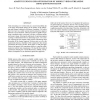Free Online Productivity Tools
i2Speak
i2Symbol
i2OCR
iTex2Img
iWeb2Print
iWeb2Shot
i2Type
iPdf2Split
iPdf2Merge
i2Bopomofo
i2Arabic
i2Style
i2Image
i2PDF
iLatex2Rtf
Sci2ools
ISCAS
2002
IEEE
2002
IEEE
Adaptive end-to-end optimization of mobile video streaming using QoS negotiation
Video streaming over wireless links is a non-trivial problem due to the large and frequent changes in the quality of the underlying radio channel combined with latency constraints. We believe that every layer in a mobile system must be prepared to adapt its behavior to its environment. Thus layers must be capable of operating in multiple modes; each mode will show a different quality and resource usage. Selecting the right mode of operation requires exchange of information between interacting layers. For example, selecting the best channel coding requires information about the quality of the channel (capacity, bit-error-rate) as well as the requirements (latency, reliability) of the compressed video stream generated by the source encoder. In this paper we study the application of our generic QoS negotiation scheme to a specific configuration for mobile video transmission. We describe the results of experiments studying the overall effectiveness, stability, and dynamics of adaptation...
| Added | 15 Jul 2010 |
| Updated | 15 Jul 2010 |
| Type | Conference |
| Year | 2002 |
| Where | ISCAS |
| Authors | Jacco R. Taal, Koen Langendoen, Arjen van der Schaaf, Hylke W. van Dijk, Reginald L. Lagendijk |
Comments (0)

